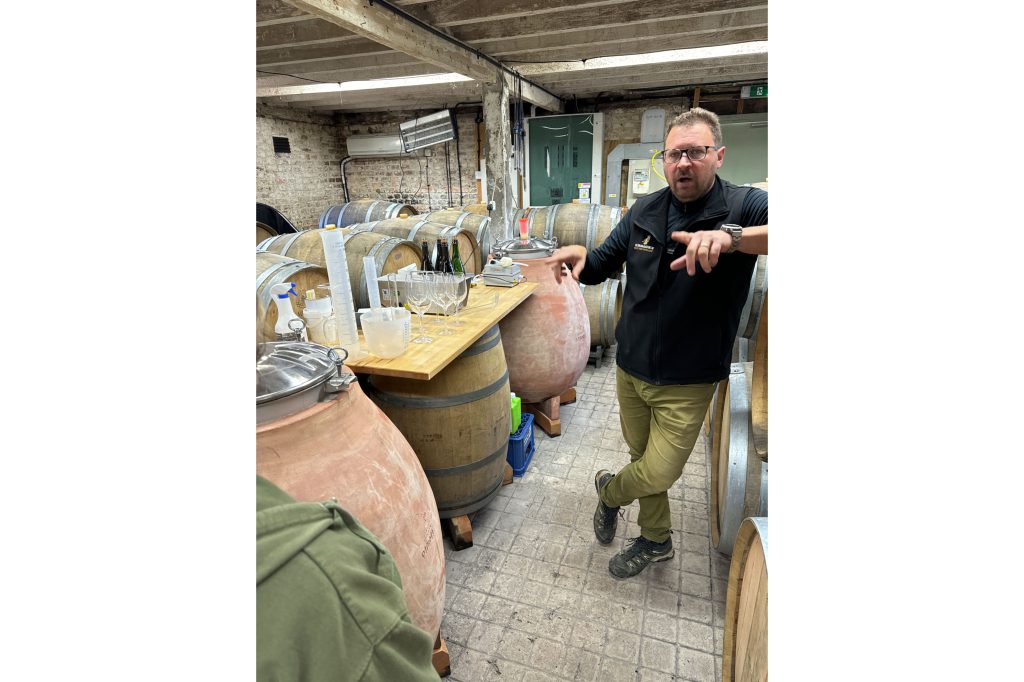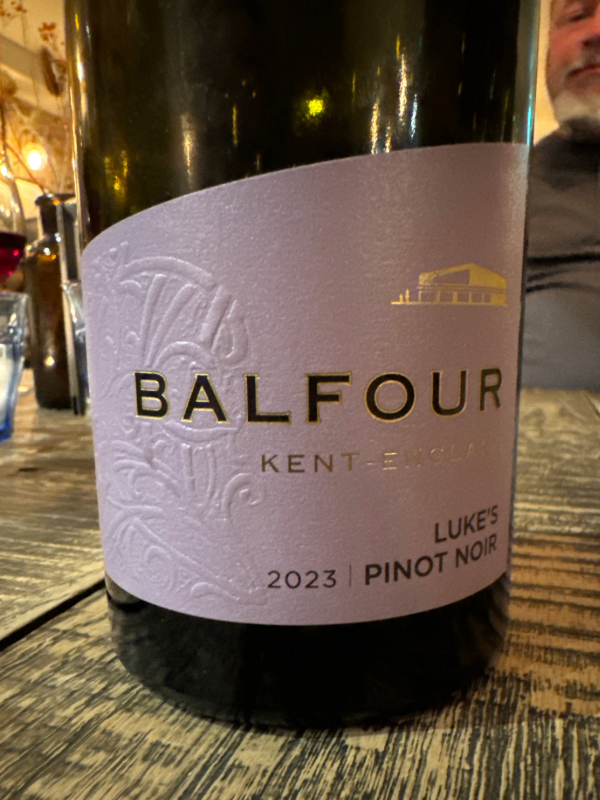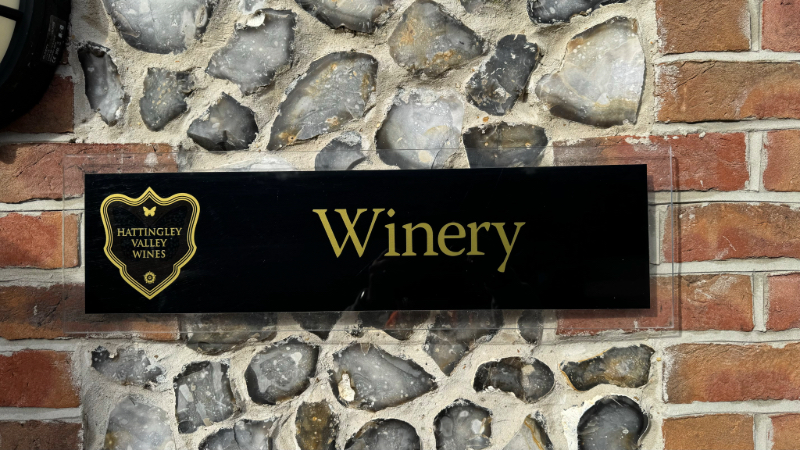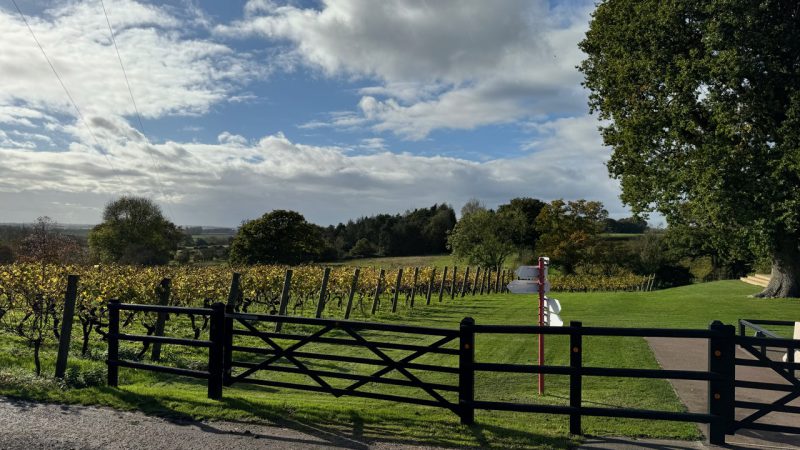My wife and I had planned a trip to England for the fall of 2020, which of course got blown apart by the COVID-19 pandemic. We were fortunate to recover all of our prepaid costs for that trip, knowing we’d have our chance at some point. That chance has come, and I bring you a report on a couple of days of tasting wine about 90 minutes or so outside London – first to the east in the Kent area, and next to the west in, curiously enough, East Hampshire.
Before we dig in, a quick word….
On an Uber car ride to pick up a rental car to head to Kent, the driver asked us what plans we had for the day, and we mentioned that we were off to visit wineries, to which he retorted “English wineries? Taste before you buy” or something to that effect. Whether he was joking or not, who, knows, but I suspect you might be having the same sort of reaction if you’ve not yet had the chance to experience any for yourself. England is thought of as a cold place, perhaps too cold for wine growing as it lies north of latitude 50, but believe it or not, intrepid souls have been at the game for 40 years or so. I’ve had the fortune in the last few years to taste several sparkling wines from the area, which made me all the more eager to visit and see for myself what’s going on.
On day one I got a look at both ends of the scale spectrum – a tiny producer with an eye toward the future, as well as the largest, likely best-known producer in the country.
Hoffmann & Rathbone is a tiny producer located near Mountfield in East Sussex, the dream of Ulrich Hoffmann and his wife Birgit Rathbone, is a work in progress – they currently use space at Mountfield Winery, and are close to starting on their own winery and tasting room. After schooling in his native Berlin, he worked in Germany, France, Spain and California (including at Napa Valley’s Cain Vineyards) before making the first vintage of Hoffmann & Rathbone in 2010. He currently consults with wineries in Italy and England in addition to his own, using that income to help fund the dream. If the wines I tasted are any indication, all the dreams are about to come true.

Hoffmann & Rathbone (England) Bacchus 2020 ($26): Bacchus is a cross of Riesling and Sylvaner, then crossed again with Muller Thurgau. Becoming known as “British Sauvignon Blanc” as a way to introduce some of its flavor profile, many examples would easily be mistaken for Sauvignon Blanc in blind tasting situations. I find this offering to be a more nuanced and expressive, like a fine dry Muscat with notes of herb and chamomile, bright acidity and a lively long finish. This has some bottle age on it, and it was clearly worth the wait. Made with a Swiss heirloom yeast called Sleeping Beauty. 92
Hoffmann & Rathbone (England) Sparkling Wine Blanc de Blancs 2013 ($68): This is 100% Chardonnay, 40% barrel fermented, and disgorged after 9 years and 9 months en tirage. It shows lemon, lime, pear and hints of brioche and peach. It is remarkably bright with a very fine mousse giving it a rich texture. Pleasing toasty notes linger long and will have you finding the bottom of the bottle in no time. This is the real deal. 96
Hoffman & Rathbone (England) Sparkling Wine “Classic Cuvée” 2015 ($56): A blend of 60% Pinot Noir, 30% Chardonnay and 10% Pinot Meunier, this shows rich autolysis aromas at pop & pour, with strawberry and cranberry notes lurking underneath. The fruit shows more on the palate, riding up to the deep toasty notes promised in the nose. The midpalate is creamy and seductive texturally, and the finish lingers with persisting toasty notes alongside the fruit. This is a very food friendly design, leaning toward Krug in style. Bravo! 96
Hoffmann & Rathbone, (England) Sparkling Rosé Reserve 2012 ($68): One of Ulrich Hoffmann’s favorite vintages to date, though one that was nearly universally shunned by the region’s makers. Most didn’t even bother to pick the vineyards that year, but, microclimates exist everywhere, including in England. The fruit for this wine missed the late rains and instead showcases what was a glorious summer that year. It’s deep in color, and that color gives a clue to the level of concentration in the wine. Ripe strawberry, cherry, notes of autolysis and stony mineral combine with zippy acidity to deliver a weighty, food friendly fizz with real finish push. Not a typical sparkling rosé, and that’s all to its credit. 96
Next stop, Chapel Down – England’s largest producer, and perhaps the best known outside the UK. Our group of four travelers did the regular tasting experience that you’d take on a visit, and we had an excellent tour guide who explained the history of the property, gave a thorough explanation of their production processes, and guided a fine tasting. Should you find yourself in the area, I highly recommend a stop for the tour and tasting – they have “upgrades” available as well.
Around since the 1980’s, they produce mainly sparkling wine, but also have a range of excellent still wines from both the Tenterden vineyards and a nearby site they call Kit’s Cody, where chalky soils and a warmer microclimate offer different flavor profiles. Here’s what I tasted:
Chapel Down, Tenterden (Kent, England) Bacchus 2023 ($20): This presents quite like a Sauvignon Blanc, but with prominent elderflower character. 2023 was a cool vintage, which shows here in the zesty acid profile, allowing the grapefruit, lemon and lime flavors to be distinct and bright. It’s built for food – oysters or a creamy fish preparation will sing with this alongside. 91
Chapel Down (England) Chardonnay 2022 ($47): This is a wild fermented, neutral barrel fermented Chardonnay that rings my favorite stylistic bells loudly. Bright acidity is the driver here, propelling a mix of apple, pear, soft vanilla, through a finish with intensity and verve. No clunkiness here, just freshness and full flavor. Try it with scallops or crab risotto. 93
Chapel Down (England) Brut Sparkling Wine NV ($40): Fresh and clean at pop and pour, the aromatics carry bright green apple, lemon and a hint of toffee. The palate turns the apple red – there’s a new variety called Cosmic Crisp that comes to mind – and lemon zest with soft toasty notes. The finish is fairly short, and that’s intentional. It’s meant to cleanse the palate between bites. Fish and chips is a natural here. 92
Chapel Down (England) Rosé Sparkling Wine ($43): This wine has picked up several accolades of late, and I’ll add to the chorus here. A blend of Chardonnay, Pinot Noir, Pinot Meunier, Pinot Blanc and what the winery calls “early” Pinot Noir, it’s lightly tinged rose gold in color, with aromas of strawberry, a little cream and bright lemon. It has a long, fruit driven finish that really pushes the strawberry out into the distance. If you’re looking for a fizzy Rosé with a weight and presence, this is it. 93
Chapel Down, Tenterden (Kent, England) Sparkling Wine “Grand Reserve” 2018 ($62): This aged vintage bubbly spent three and a half years on the lees prior to disgorging, and that extra rest shows in the glass. Aromas of apple, quince, a little cardamom spice and toasted bread translate directly to palate flavors on a fleshy texture. This is long and expressive to the end, and it has a long, interesting life ahead. Delightful! Contains 60% Chardonnay, 28% Pinot Noir and 12% Pinot Meunier. 94
Chapel Down continues to pioneer, even going so far as to be experimenting with English oak barrels, and things like light style bulk process bubbly. Good on them for looking for ways to draw people into the wine market that may not otherwise try to crack the code.
While I couldn’t get an appointment in the time window allotted to visit nearby Balfour Winery, a stay at their nearby Goudhurst Inn allowed me a few tastes with dinner:
Balfour, Kent (England) Sparkling Wine “Leslie’s Reserve Rosé NV ($45): It seems that Sparkling Rosé is gaining a foothold in England among producers, and for good reason. Regional acid profiles make pretty jazzy iterations possible, and this fits the category well. Fresh strawberry and lemon zest are present boldly from start to finish, and the texture is crisp, clean and bright throughout. Simple, but pure and pleasing. 92

Balfour Winery, Kent (England) Pinot Noir “Luke’s” 2023 ($40): If you’re expecting Burgundy or Sonoma, this isn’t the ticket, but then again it isn’t intended to be. It’s very light in color (a fine magnifying glass) but not at all shy in aroma or flavor, delivering strawberry, cranberry and damp earth (perhaps not a surprise) tones. It shows lively acidity and a long, well integrated finish even at this young age. Solid! 92
After the nights stay at Goudhurst Inn (highly recommended, by the way – very comfortable and a fine restaurant attached) a couple hours of “other side” driving to the west landed us in Hampshire at Hattingley Valley Winery. It was initiated in 2010 by Simon Robinson, whose law career allowed him to purchase farm land in Hampshire. A radio show on the up-and-coming wine scene in England inspired him to dive in and plant grapes, landing on a band of chalky soil to get things started. Under the original winemaker Emma Rice and current winemaker Robert MacCulloch MW, the winery consults with and bottles for other customers as well as its own brand, which is now fully half of the work that happens at the winery.

Sourcing their own fruit as well as selected other sites from across southern England, you’ll see the macro appellation on the bottle, but fear not – this allows the house styled non-vintage sparkler to have a consistent personality year over year. Of course, they offer vintage offerings and still wines as well. A quick look:
Hattingley Valley (England) Sparkling Wine Brut “Classic Reserve” NV ($47): In the traditional Champagne style, this is a blend of multiple vintage reserve wines to get at a consistent house style that the public will recognize as such. The focus here is on tempering the regional acidity, which can be bracing to say the least. That said, the tempering is carefully done, bringing everything to a beautiful balance point. The result is a wine that feels full in the mouth, with flavors of apple, moderate toasty character, lemon zest and a persistent finish. It’s quite delicious, and a nice contrast to the more acid driven local competition. Fear not, there’s still plenty enough acidity to keep things fresh and lively. 93
Hattingley Valley (England) Sparkling Rosé Brut 2020 ($53): Rosé was not originally intended for the winery line, but it’s a brilliant add. Strawberry and citrus aromas translate with purity and pizazz, and there’s a little earthy note that lingers underneath the fruit. The creamy midpalate leads to a crisp finish that leaves a long retronasal impression. This has lots of pairing possibilities. Contains 66% Pinot Noir, 33% Pinot Meunier and 1% Pinot Noir Précoce (a dark skinned mutation of Pinot Noir). 93
Hattingley Valley (England) Sparkling Wine Blanc de Blancs 2015 ($64): This 100% Chardonnay offering spent 8 years on the lees prior to disgorgement, and the payoff is a rich nose of baked bread and malt. A pop of malt hits the palate first, and quickly gives way to bright apple, lemon and toasted bread that push boldly through a long finish. This is great stuff ! 95
Still by Hattingley (England) Chardonnay 2022 ($34): One of the first in the portfolio made by current winemaker Robert MacCulloch MW (Master of Wine – nice get!) and it’s the sort of wine that is remaking the category and getting thousands to drop their ABC (anything but Chardonnay) membership. With less than one gram per liter of residual sugar, the wine bursts with acidity, yet remains fruit focused, with apple and citrus, soft herb character and a finish that really hangs in. It may take your palate a second to adjust, but trust me – take that second and see what English Chardonnay can be. 93
This handful of wines alone make a solid argument for the region, but if you need more convincing, be aware that Pommery (currently at Hattingley) and Tattinger are already producing wines here, and Jackson Family has begun purchasing property. Located just about two hundred miles from Champagne, and carrying temperature averages that Champagne has not seen for two or more decades, and you can bet that more will be looking to move in. Sounds like wise planning to me.
A huge thank you to Uli, Andrew, David, and Channing for showing us around – my crew and I hope for a return visit in the not too distant future. And, if I sound more British than usual, I apologize, but I have to say the lot is a bit contagious. Cheers!

